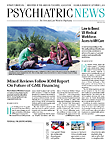More than a decade ago, a team of mental health professionals initiated a study that would eventually show that an 82 percent reduction in a psychiatric hospital’s rates for seclusion and restraint use could be achieved within a relatively short time, simply by making the physical environment more aesthetically pleasing.
In a report published July 15 in Psychiatric Services in Advance, the researchers updated their data to show whether their intervention method can sustain such a reduction in use of seclusion and restraint over an extended period of time.
In the first decade of this century, there was a major effort to lessen the use of seclusion and restraint for patients in mental health facilities. Government health agencies and mental health care organizations—including APA—were heavily involved in these efforts to curb seclusion and restraint use, stressing that these practices can be countertherapeutic for patients (Psychiatric News, 2003).
“While several calls were made to reduce seclusion and restraint within inpatient settings, there was not a lot of research out there about how this [reduction] could be achieved,” commented the study’s lead author Alok Madan, Ph.D., M.P.H., an associate professor of psychiatry at the Menninger Clinic, during an interview with Psychiatric News.
A former research fellow at the Institute of Psychiatry (IOP) at the Medical University of South Carolina, Madan was part of the earlier study whose findings were published in Psychiatric Services in 2011. That study involved the implementation of a multicomponent intervention plan to minimize seclusion and restraint use at the IOP. Findings from that study showed that changes to the physical environment—such as repainting walls with warm colors, using decorative rugs, and restructuring furniture in common areas—were the only interventions associated with a significant drop in the rates of seclusion and restraint from the beginning of 2005 to mid-2008, whereas interventions such as increased trauma-informed training for hospital staff and shared decision making practices did not lead to a similar result.
In their current study, the researchers expanded upon these findings to assess whether the reduced rates of seclusion and restraint associated with modification of the physical atmosphere could be sustained beyond 2008.
To answer that question, Madan and colleagues gathered information on seclusion and restraint rates at the IOP over multiple time periods: baseline, which included no prior modification to the facility’s physical environment (January 2003 to December 2004); the implementation period in which modifications were made to the physical environment (January 2005 to March 2008); an initial follow-up period (April 2008 to June 2008); and an extended follow-up period in which concerted efforts to further reduce seclusion and restraint were no longer being tried (July 2008 to December 2012).
The results showed that rates of seclusion and restraint were reduced during the initial follow-up period and that this reduction was sustained throughout the extended follow-up period.
“We are the first group to look at sustained results in this format,” said Susan Hardesty, M.D., medical director and a senior vice president at Menninger. She explained to Psychiatric News that though she and her colleagues left the IOP within the 10-year period studied, the reduction in seclusion and restraint practices as a result of improvements to the facility’s physical environment proved to be long lasting—even in the midst of an administration shift.
Hardesty added that not only does an aesthetically pleasing environment benefit the mental health of patients, but it may also benefit that of faculty and staff. “People like coming to work in a presentable environment.”
The researchers did note, however, that there may be some limits to the benefits of environmental improvements, since no further reduction in seclusion and restraint use was observed between the initial follow-up period and the extended follow-up. They concluded that future research should focus more on pinpointing the specific environmental and design features that may directly deter seclusion and restraint use.
The study was funded by the Menninger Foundation and the McNair Medical Institute. ■
An abstract of “Efforts to Reduce Seclusion and Restraint Use in a State Psychiatric Hospital: A Ten-Year Perspective” can be accessed
here.

